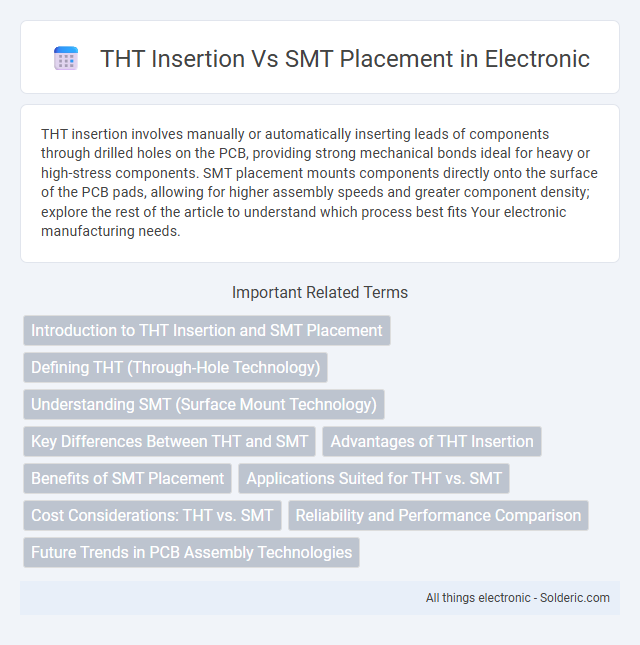THT insertion involves manually or automatically inserting leads of components through drilled holes on the PCB, providing strong mechanical bonds ideal for heavy or high-stress components. SMT placement mounts components directly onto the surface of the PCB pads, allowing for higher assembly speeds and greater component density; explore the rest of the article to understand which process best fits Your electronic manufacturing needs.
Comparison Table
| Feature | THT Insertion | SMT Placement |
|---|---|---|
| Mounting Type | Through-Hole Technology (leads inserted into drilled holes) | Surface Mount Technology (components placed on PCB surface) |
| Component Size | Larger, bulkier components | Smaller, compact components |
| Assembly Speed | Slower due to manual or wave soldering | Faster with automated pick-and-place machines |
| Mechanical Strength | Higher mechanical strength and reliability | Lower mechanical strength, sensitive to PCB flex |
| Cost | Generally higher production cost | Lower cost due to automation and material savings |
| Design Complexity | Limited component density and layout complexity | Supports high-density and complex PCB layouts |
| Rework & Repair | Easier to rework and repair manually | More difficult rework, requires precision tools |
| Typical Applications | High-reliability, mechanical stress environments | Consumer electronics, mobile devices, complex circuits |
Introduction to THT Insertion and SMT Placement
Through-Hole Technology (THT) insertion involves mounting electronic components by inserting leads through pre-drilled holes on a printed circuit board (PCB), offering strong mechanical bonds ideal for heavy or high-stress components. Surface-Mount Technology (SMT) placement attaches components directly onto the surface of the PCB without drilling, enabling higher component density and automated assembly with faster production times. Both techniques are essential in modern electronics manufacturing, with THT suited for robust connections and SMT providing compact, efficient layouts.
Defining THT (Through-Hole Technology)
Through-Hole Technology (THT) involves inserting electronic components with leads through pre-drilled holes on a printed circuit board (PCB), providing strong mechanical bonds ideal for heavy or high-stress components. This method contrasts with Surface-Mount Technology (SMT), where components are placed directly on the PCB surface without leads extending through the board. Your choice between THT and SMT depends on factors like durability requirements, component size, and production volume.
Understanding SMT (Surface Mount Technology)
SMT (Surface Mount Technology) involves mounting electronic components directly onto the surface of printed circuit boards (PCBs), enabling higher component density and improved performance compared to THT (Through-Hole Technology). SMT components are smaller and soldered on the board's surface, which allows for automated assembly, reduced production time, and lower manufacturing costs. Understanding SMT helps you optimize PCB design for compactness and efficiency in modern electronic devices.
Key Differences Between THT and SMT
THT (Through-Hole Technology) insertion involves mounting components by inserting leads through pre-drilled holes on the PCB, offering strong mechanical bonds suitable for heavy or high-stress components. SMT (Surface-Mount Technology) placement attaches components directly onto the PCB surface, enabling higher circuit density and automated assembly with smaller, lighter parts. Understanding these differences helps optimize your manufacturing process for performance, cost, and reliability needs.
Advantages of THT Insertion
THT (Through-Hole Technology) insertion offers superior mechanical strength compared to SMT (Surface-Mount Technology) placement, making it ideal for components subjected to high stress or thermal cycling. It provides enhanced reliability in applications requiring durable connections, such as automotive and aerospace electronics. Furthermore, THT facilitates easier prototyping and manual soldering, supporting effective testing and repair processes.
Benefits of SMT Placement
SMT placement offers higher component density and enables smaller, lighter electronic devices due to its surface-mounted design. It enhances manufacturing efficiency by supporting automated assembly processes, reducing production time and minimizing human error. Your products benefit from improved electrical performance and reliability, as SMT components have shorter lead lengths and better resistance to vibration and mechanical stress.
Applications Suited for THT vs. SMT
Through-hole technology (THT) is ideal for applications requiring strong mechanical bonds and high durability, such as connectors, transformers, and components exposed to mechanical stress or high temperatures in automotive, aerospace, and industrial equipment. Surface-mount technology (SMT) suits high-density, miniaturized devices like smartphones, consumer electronics, and complex circuit boards where space-saving and automated assembly are critical. Your choice between THT and SMT depends on the balance between mechanical strength, application environment, and manufacturing volume.
Cost Considerations: THT vs. SMT
THT insertion typically incurs higher labor costs due to manual placement and wave soldering processes, whereas SMT placement benefits from automated pick-and-place machines, reducing assembly time and labor expenses. Component costs for THT can be higher because through-hole parts generally have larger packaging, impacting PCB space and material usage. SMT offers cost advantages through higher production volumes, smaller component sizes, and more efficient use of PCB real estate, leading to lower overall manufacturing costs.
Reliability and Performance Comparison
Through-hole technology (THT) insertion offers superior mechanical strength, making it more reliable in high-stress and high-vibration environments compared to surface-mount technology (SMT) placement. SMT placement excels in high-frequency applications due to reduced lead inductance and better electrical performance, enhancing signal integrity and overall circuit speed. Reliability of SMT improves with advanced soldering techniques, but THT remains preferred for components requiring robust physical connections.
Future Trends in PCB Assembly Technologies
Future trends in PCB assembly technologies increasingly favor SMT placement due to its efficiency, miniaturization capabilities, and suitability for high-density circuits compared to THT insertion. Advancements in automated SMT machines, including laser-based alignment and AI-driven process control, enhance precision and throughput. Your choice of assembly method will likely lean toward SMT as manufacturers prioritize faster production cycles and compact design integration.
THT insertion vs SMT placement Infographic

 solderic.com
solderic.com